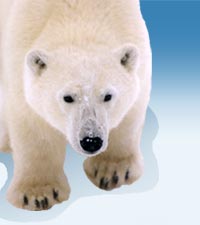
Polar Bear Parts
Height and length
 Polar bears can seem surprisingly small from a distance. Even up close, it is easy to forget how large they are, until they stand up on
their hind legs. They can stretch themselves out so their nose can reach out as far as their front paws can, which means they have very
long necks. Even high up in the safety of a Tundra Buggy, polar bears have been know
to stick their nose in the windows! When stretched out, a polar bear can be 3m (10') long. A polar bear standing on all fours may be 1m (3') high or more.
Polar bears can seem surprisingly small from a distance. Even up close, it is easy to forget how large they are, until they stand up on
their hind legs. They can stretch themselves out so their nose can reach out as far as their front paws can, which means they have very
long necks. Even high up in the safety of a Tundra Buggy, polar bears have been know
to stick their nose in the windows! When stretched out, a polar bear can be 3m (10') long. A polar bear standing on all fours may be 1m (3') high or more.
Weight
Boars tend to be larger than sows. A boar can weigh 500-600kg (1100-1300lbs). Sows can weight 300kg (650lbs), unless they are pregnant when they can weigh as much as a male.
The largest polar bear ever found was a gigantic boar that was 1002kg (2209lbs) and was 3.7m (12') long. If there are 25 students in a class, and each one weighs about 40 kg (88lbs), the bear would have weighed the same as the entire class!
Paws
Polar bears have four large paws, that can be 30cm (12") across. Imagine having feet that were as large as dinner plates! Their giant paws act like snowshoes to spread the polar bear's weight out so they can walk on thin ice. A polar bear has five toes on each foot, and there is a sharp claw at the end of each toe. The claws are used to catch food and to defend him or herself from other polar bears, and scratch those pesky itches.
Between each toe is a little bit of skin, which makes a polar bear's paw a little bit like a seal's flipper and helps them swim easily through the water.
The bottom of a bear's paw is has lots of little bumps on it, like the surface of a basketball, which helps the bear get a good grip on the ice and keep them from slipping.
Neck and head
 Polar bears spend lots of time in the water and their long necks allow them to get a better look at where they are going. Male and female
polar bears have different types of necks. A female's neck is smaller than her head, which is the same as people. A male's have such
strong and big necks, that their neck is larger than their head.
Polar bears spend lots of time in the water and their long necks allow them to get a better look at where they are going. Male and female
polar bears have different types of necks. A female's neck is smaller than her head, which is the same as people. A male's have such
strong and big necks, that their neck is larger than their head.
Imagine that your finger is a polar bear's head and neck. The tip of your finger is the bear's head (you can draw a face on the tip of your finger), and the rest of your finger is the bear's neck. Researcher's cannot put collars on male polar bears, because the collar would slip off the bear's head, just like you can slip a ring off your finger.
Polar bears have two dark eyes, two fuzzy ears and a very sensitive nose, which help them to find food.
Teeth and Tongue
 42 teeth line the inside of a polar bear's mouth. The teeth are used to catch food, tear off pieces of meat and scare off other polar bears. Polar bear's don't chew their food much, and like to swallow large pieces of food. Polar bears have longer, sharper teeth than grizzly bears.
42 teeth line the inside of a polar bear's mouth. The teeth are used to catch food, tear off pieces of meat and scare off other polar bears. Polar bear's don't chew their food much, and like to swallow large pieces of food. Polar bears have longer, sharper teeth than grizzly bears.
Most people think that a polar bear has a pink tongue but they have dark blue and black tongue (and really bad breath!).
Tail
Polar bears have a small flat tail that is 7-12cm (3-5") long. It is usually difficult to see the tail, until a polar bear has to go to the bathroom, when he or she lifts the tail up.
Age
Polar bears have been known to live for 20 years or more, although few live longer than their late teens. The oldest wild polar bear was 32 years old, and the oldest polar bear in a zoo was 41 years old.
Researchers can find out how old a polar bear is by removing a tooth. Each year, a bear's teeth grow a little larger. The end of the tooth is cut off and there is a ring for each year, just like on trees. The researchers simply count the rings to find out how old polar bears are. 5 rings means a polar bear is five years old.
All photos and images are for use at the author's discretion.
Please gain permission before using.
Copyright © 2000-2004 mikepolarbear@yahoo.ca
Please gain permission before using.
Copyright © 2000-2004 mikepolarbear@yahoo.ca

